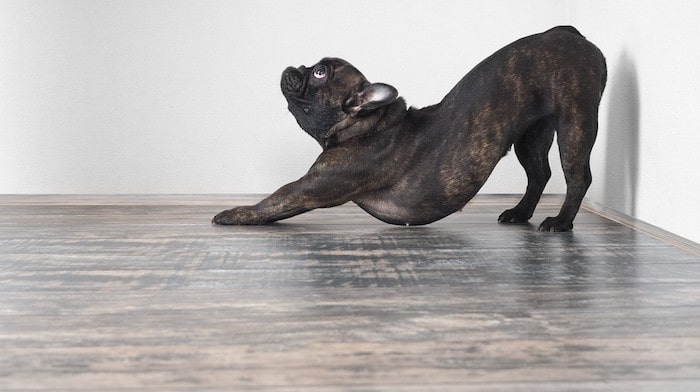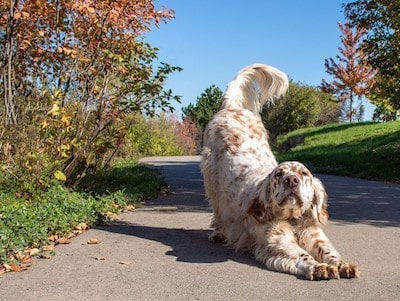Have you ever wondered why your dog stretches so much? Whether it’s during the morning wake-up routine, after a nap, or even in the midst of playtime, dogs seem to find endless opportunities to stretch their bodies. But what drives this instinctive behavior? Is it purely a physical necessity or does it carry deeper meanings?
Join us as we unravel the mystery behind why our dogs stretch so much and discover the intriguing insights into their world of flexibility and well-being. So, let’s embark on this stretch-filled journey together and uncover the secrets behind our canine companions’ stretches.
What Is Dog Stretching and Why Is it Important?
Dog stretching is the act of extending or flexing the muscles and joints of the body. Dogs stretch for various reasons, such as to relieve tension, to prepare for activity, to express emotions, or to communicate with other dogs or humans. Stretching is important for dogs because it helps them maintain their flexibility, mobility, circulation, and mood.
Flexibility is the ability of the muscles and joints to move through their full range of motion without pain or stiffness. Flexibility helps dogs perform various activities, such as running, jumping, playing, or climbing stairs. It also prevents injuries and reduces the risk of arthritis and other joint problems.
Mobility is the ability of the muscles and joints to move freely and smoothly without restriction or difficulty. Mobility helps dogs move around with ease and comfort. It also supports their balance, coordination, agility, and posture.

Circulation is the flow of blood and oxygen throughout the body. Circulation helps dogs deliver nutrients and oxygen to their cells and organs, and remove waste products and toxins from their system. It also regulates their body temperature, blood pressure, heart rate, and immune system.
Mood is the emotional state or feeling of the dog. Mood affects how dogs perceive and react to their environment and situations. Stretching can improve dogs’ mood by releasing endorphins, which are natural chemicals that make them feel happy and relaxed. Stretching can also reduce stress, anxiety, depression, and boredom in dogs.
Different Types of Dog Stretching
Dogs can stretch in different ways depending on their needs, preferences, and situations. Some of the most common types of dog stretching are:
- The play bow: This is when the dog lowers their front legs and chest to the ground while keeping their rear end up in the air. This stretch indicates that the dog is playful, friendly, and inviting another dog or human to play with them.
- The downward-facing dog: This is when the dog pushes their front legs forward while keeping their rear end up in the air. This stretch elongates the spine and stretches the back, shoulders, chest, legs, and paws.
- The upward-facing dog: This is when the dog lifts their chest up while keeping their front legs straight and their rear end down on the ground. This stretch arches the back and stretches the abdomen, neck, chest, shoulders, and front legs.
- The side stretch: This is when the dog bends their body sideways while keeping their legs straight. This stretch stretches the side muscles of the body.
- The back leg stretch: This is when the dog extends their back leg behind them while keeping their front legs straight. This stretch stretches the hips, lower back, and back legs.
- The cookie stretch: This is when the dog reaches for a treat or toy with their nose while keeping their rear end on the ground. This stretch stretches the neck, chest, shoulders, front legs, and paws.
The Benefits of Dog Stretching
Dog stretching has many benefits for your dog’s physical and mental well-being. Here are some of the main ones:
- Keeping muscles supple and flexible: Stretching helps your dog maintain their muscle tone and elasticity, which prevents stiffness, soreness, and injury. Stretching also improves your dog’s range of motion and agility, which allows them to perform better in physical activities and avoid accidents.
- Boosting circulation: Stretching stimulates blood flow to your dog’s muscles, organs, and tissues, which delivers oxygen and nutrients and removes waste products. This enhances your dog’s metabolism, immune system, and healing process.

- Increasing oxygenation and hydration: Stretching also helps your dog breathe deeper and drink more water, which increases their oxygen intake and hydration levels. This supports your dog’s energy production, brain function, and skin health.
- Enhancing dog/person bond: Stretching with your dog can strengthen your relationship with them, as it shows them that you care about their well-being and comfort. Stretching can also be a form of communication and affection between you and your dog, as you can read their body language and respond accordingly.
- Engendering feelings of calm and contentment: Stretching can help your dog relax and release tension from their body and mind. Stretching can also trigger the release of endorphins, which are natural chemicals that make your dog feel happy and satisfied.
The Common Reasons Why Dogs Stretch
Dogs stretch for various reasons in different situations and contexts. Here are some of the most common ones:
- To relieve muscle tension after being active or lying down for a long time: This is probably the most obvious reason why dogs stretch. After running, jumping, or sleeping, your dog’s muscles may feel tight or cramped. Stretching helps them loosen up and restore their normal function.
- To alleviate pain or discomfort from digestive issues or bloating: Sometimes, your dog may stretch to ease the pressure or pain in their stomach or intestines. This may be caused by eating too much, eating something bad, or having gas or constipation. Stretching can help your dog expel the excess air or food and feel more comfortable.
- To show submission or appeasement to other dogs or humans: Sometimes, your dog may stretch to signal that they are not a threat or that they want to avoid conflict. This may happen when they meet a new or dominant dog or when they sense that you are angry or upset with them. Stretching can show that your dog respects the other party’s authority or wishes.

- To display mating behavior or readiness: Sometimes, your dog may stretch to attract or entice a potential mate. This may happen when they are in heat or when they encounter an attractive or compatible partner. Stretching can show that your dog is interested in mating or that they are ready to mate.
- To express mixed emotions or signals: Sometimes, your dog may stretch to convey a complex or ambiguous message to another dog or human. This may happen when they are unsure how to react or what to do in a certain situation. Stretching can show that your dog is feeling conflicted, curious, playful, nervous, excited, etc.
- To keep cool or regulate body temperature: Sometimes, your dog may stretch to adjust their body temperature according to the environment. This may happen when they are too hot or too cold. Stretching can help your dog dissipate heat or conserve heat by exposing or covering their body parts.
- To play or invite play: Sometimes, your dog may stretch to initiate or engage in play with another dog or human. This may happen when they are bored or energetic. Stretching can show that your dog is in a playful mood or that they want to have some fun.
Signs of Excessive or Abnormal Stretching
While stretching is generally a normal and healthy behavior for dogs, sometimes it can indicate that something is wrong with your dog. Here are some of the signs that suggest that your dog’s stretching may be excessive or abnormal:
- Stretching more frequently or longer than usual: If your dog stretches more often or for longer periods than they normally do, it may mean that they are experiencing some discomfort or pain in their body. This may be due to an injury, illness, or condition that affects their muscles, joints, nerves, or organs.
- Stretching in a strange or unnatural way: If your dog stretches in a way that looks odd or unnatural, it may mean that they are trying to compensate for some weakness or imbalance in their body. This may be due to a congenital defect, a developmental issue, or a degenerative problem that affects their structure or function.
- Stretching combined with other symptoms: If your dog stretches along with other signs of distress or disease, such as vomiting, diarrhea, drooling, gurgling sounds, etc., it may mean that they are suffering from a serious or life-threatening condition. This may be due to an infection, an inflammation, a blockage, a rupture, or a poisoning that affects their digestive system or other vital organs.
- Stretching due to an injury, illness, or condition: If your dog stretches because of a known or diagnosed injury, illness, or condition, such as arthritis, pancreatitis, bloat, etc., it may mean that they are coping with the pain or discomfort caused by the problem. This may be due to an acute or chronic issue that affects their quality of life.

These are just some of the signs that indicate that your dog’s stretching may be excessive or abnormal. As you can see, stretching can sometimes be a warning sign of a potential health hazard for your dog.
If you notice any of these signs in your dog, you should do the following:
- Monitor your dog’s behavior and health closely: Keep an eye on your dog’s stretching habits and patterns and check for any changes or abnormalities. Also observe your dog’s general appearance and demeanor and look for any signs of distress or disease.
- Consult your veterinarian for diagnosis and treatment: If you suspect that your dog’s stretching is due to an injury, illness, or condition, you should take them to your veterinarian as soon as possible for a proper diagnosis and treatment. Your veterinarian will examine your dog and perform some tests to determine the cause and severity of the problem and prescribe the best course of action.
- Follow your veterinarian’s advice and recommendations: If your veterinarian gives you any advice or recommendations regarding your dog’s stretching or health issue, you should follow them carefully and faithfully. Your veterinarian will advise you on how to manage your dog’s pain or discomfort, how to prevent further complications or infections, how to administer medications or supplements, etc.
- Provide your dog with comfort and care: If your dog’s stretching is due to an injury, illness, or condition, you should provide them with comfort and care to help them recover and heal. You should give them plenty of water and food (unless otherwise instructed by your veterinarian), keep them warm and cozy (or cool and ventilated), give them gentle massages or rubs (if they enjoy them), and show them love and support.
FAQs
Absolutely! Dogs often stretch during play to release pent-up energy and enhance their physical performance. Encouraging stretching during play can be beneficial, as it helps prevent muscle strains and injuries and improves their overall flexibility.
Yes, different breeds may exhibit variations in their stretching behaviors. Some breeds are naturally more flexible than others due to their physical build and genetic traits. Larger breeds might have more elaborate stretching routines compared to smaller breeds.
Dogs may stretch more frequently as they age. Just like humans, older dogs can experience age-related stiffness, and stretching becomes even more crucial for maintaining their mobility and preventing muscle atrophy.
Yes, it is quite common for dogs to yawn and stretch together, especially during their morning rituals. This combination of behaviors helps them wake up fully and get ready for the day ahead.
Well, That’s a Wrap
In conclusion, the simple act of stretching holds a deeper significance in the lives of our canine companions. From aiding in muscle flexibility and blood circulation to serving as a form of communication and relaxation, stretching plays a vital role in their physical and emotional well-being. Understanding why dogs stretch so much allows us to connect more profoundly with our furry friends, enhancing the bond we share.
As responsible pet owners, we should embrace and encourage our dogs’ stretching behaviors, incorporating it into their daily routines. Whether it’s joining them in some playful stretching during playtime or simply being observant of their stretching habits, we can actively contribute to their overall health and happiness.
Remember that while regular stretching is usually natural and healthy for dogs, any significant changes in their stretching patterns or signs of discomfort should prompt a visit to the veterinarian. Being attentive to their needs and ensuring they have a comfortable and safe environment is key to fostering a long and fulfilling life for our beloved companions.

Ellis is a retired veterinary technician and full-time contributor at DogLovesBest. He likes writing about pet health care tips and reviews the products that are useful for fidos on a daily basis.
Ellis also guardians a Siberian husky, Nova, and a cat named Shilly. They all live happily with his wife Ammy, and both the dogs on a seaside apartment in Queens, NY.
